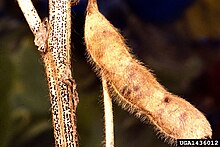| Diaporthe phaseolorum var. sojae | |
|---|---|

| |
| Diaporthe phaseolorum var. sojae damage to soybean (Glycine max). | |
| Scientific classification | |
| Domain: | Eukaryota |
| Kingdom: | Fungi |
| Division: | Ascomycota |
| Class: | Sordariomycetes |
| Order: | Diaporthales |
| Family: | Diaporthaceae |
| Genus: | Diaporthe |
| Species: | |
| Variety: | D. p. var. sojae
|
| Trinomial name | |
| Diaporthe phaseolorum var. sojae (Lehman) Wehm., (1933)
| |
| Synonyms | |
|
Diaporthe sojae | |
Diaporthe phaseolorum var. sojae is a plant pathogen infecting soybean[1] and peanut.
Diaporthe phaseolorum var. sojae is the perfect form of the causal pathogen of pod and stem blight of soybean.[2] It is a fungal ascomycete that commonly infects seeds, pods, stems, and petioles. This pathogen is also found in its imperfect state, Phomopsis sojae. This is a common disease of most soybean growing regions in the United States. Losses result from losses in field stands, reductions in yield, and poor seed quality.[3]
- ^ Bennett, J. Michael; Rhetoric, Emeritus; Hicks, Dale R.; Naeve, Seth L.; Bennett, Nancy Bush (2014). The Minnesota Soybean Field Book (PDF). St Paul, MN: University of Minnesota Extension. p. 83. Archived from the original (PDF) on 30 September 2013. Retrieved 21 February 2016.
- ^ Mueller, Daren and Alison Robertson. "Soybean Diseases." Iowa State University of Science and Technology. (2010): 28.
- ^ Malvick, Dean K. Pod and Stem Blight, Stem Canker, and Phomopsis Seed Decay of Soybeans. Urbana-Champaign: Department of Crop Sciences University of Illinois at Urbana-Champaign, 1997.